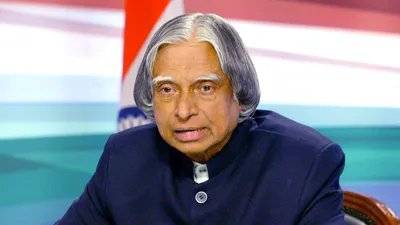True legends are rare; they grace the world only once in a century and live on in our hearts for generations. Dr. APJ Abdul Kalam, affectionately known as the “People’s President,” stands as one such remarkable figure who transformed dreams into reality. Born as Avul Pakir Jainulabdeen Abdul Kalam on October 15, 1931, in Rameswaram, his journey from humble beginnings to becoming India’s 11th President is a testament to resilience and vision. A pioneering scientist, Dr. Kalam spearheaded India’s missile and nuclear programs, paving the way for national strength and scientific progress.
To journey through his life is to witness pure dedication and unyielding spirit. Let’s delve into the inspiring life story of this remarkable leader.
Dr. APJ Abdul Kalam’s Early Life And Education
Born into a humble Muslim family as the youngest of five, Dr. APJ Abdul Kalam’s early life was marked by resilience and a passion for learning that overcame financial hardships. Known for his brilliance in mathematics, young Kalam’s academic prowess set him apart, leading him to Saint Joseph’s College in Tiruchirappalli, where he earned his Physics degree in 1954.
But he didn’t stop there—driven by an unbreakable spirit, he pursued Aeronautical Engineering at the esteemed Madras Institute of Technology, graduating in 1960. This journey was just the beginning of a remarkable legacy that would inspire a nation and transform him into the “Missile Man” of India.
Dr. APJ Abdul Kalam: Family Background and Personal Life
Dr. A.P.J. Abdul Kalam, known as the “Missile Man of India,” was a renowned aerospace scientist and the 11th President of India. He played a pivotal role in India’s space and missile development programs and is remembered for his vision of a developed India. Beyond his professional achievements, Dr. Kalam’s family background significantly shaped his character and values.
Family Background
Birth and Early Life
Dr. Kalam was born on October 15, 1931, in Rameswaram, Tamil Nadu, to a modest family. His father, Jainulabdeen Marakayar, was a boat owner and a significant influence in Kalam’s life. His mother, Ashiamma, was a homemaker. The family lived a humble life, which instilled in Dr. Kalam the values of hard work, dedication, and perseverance.
Parents
- Father: Jainulabdeen Marakayar
Jainulabdeen was a caring and supportive father who had limited formal education but was well-respected in his community. He played a crucial role in shaping Kalam’s early life and values. Jainulabdeen encouraged his children to pursue education and fostered a spirit of inquiry and learning. - Mother: Ashiamma
Ashiamma was a loving mother who managed the household and supported her husband’s work. She was known for her wisdom and guidance, nurturing her children with love and instilling in them strong moral values. Her influence was significant in Dr. Kalam’s formative years.
Siblings
Dr. Kalam had a close-knit family and was the youngest of four siblings. Here’s a brief overview of his siblings:
- Brother:
- Name: Muthumalai Kalam
- Dr. Kalam’s elder brother, Muthumalai, played a significant role in his early life. He supported the family financially and contributed to their education. Muthumalai’s dedication to family welfare had a lasting impact on Dr. Kalam.
- Sisters:
- Name: Amina Kalam
- Amina was one of Dr. Kalam’s sisters. She contributed to the household in her own ways and, like her mother, instilled values of dedication and care within the family.
- Name: Zohara Kalam
- Zohara was another sister of Dr. Kalam. The siblings shared a strong bond and supported each other through their education and life challenges.
Dr. APJ Abdul Kalam Career in Science
Dr. A.P.J. Abdul Kalam’s inspiring journey in science began at the Defence Research and Development Organisation (DRDO), where he worked on creating a hovercraft—his first step into the world of engineering and innovation. His career took a major leap in 1969 when he joined the Indian Space Research Organisation (ISRO) as the project director of the SLV-III mission. Leading a dedicated team, Dr. Kalam helped launch the Rohini satellite into orbit in 1980, marking a proud milestone that boosted India’s space capabilities.
In the late 1980s, he turned his focus to missile technology, leading the ambitious Integrated Guided Missile Development Programme (IGMDP). Through his efforts, India developed the powerful AGNI and PRITHVI missiles, strengthening the country’s defense and establishing Dr. Kalam as a key figure in India’s technological journey. His work not only advanced science but also inspired generations, making him a true pioneer in the nation’s scientific progress.
DR APJ Abdul Kalam Political Career
Political Journey of Dr. A.P.J. Abdul Kalam: A Visionary Leader
Dr. A.P.J. Abdul Kalam’s remarkable scientific achievements earned him the position of Scientific Adviser to the Defence Minister from 1992 to 1999. His dedication and expertise were instrumental in advancing India’s nuclear capabilities, especially with the historic Pokhran-II nuclear tests in 1998. These successful tests not only demonstrated India’s strength but also established it as a nuclear power on the global stage.
In 2002, Kalam achieved another milestone by becoming the President of India, with strong support from both the ruling Bharatiya Janata Party and the opposition Congress Party—a rare political consensus that reflected his universal respect and appeal. As President, Dr. Kalam had a bold vision for India’s future. He initiated Technology Vision 2020, an ambitious project aimed at driving technological advancement across all sectors. His ultimate goal was to transform India into a developed nation by 2020, laying a strong foundation for a brighter, technologically driven future.
Dr. Kalam’s legacy as a visionary leader continues to inspire millions, showing the power of innovation, unity, and dedication to national progress.
DR APJ Abdul Kalam legacy And Science
After wrapping up his presidential term in 2007, Dr. APJ Abdul Kalam dove back into academia and public life with an unwavering passion. He became a beacon of inspiration for young minds, delivering captivating lectures and sharing his wisdom through several books. One of his most celebrated works, the autobiography Wings of Fire, resonated deeply with millions, igniting their dreams and aspirations.
Tragically, on July 27, 2015, while giving a lecture at the Indian Institute of Management Shillong, Dr. Kalam passed away. His death left the entire nation heartbroken, as he was more than just a leader; he was a guiding light for countless Indians who looked up to him. His legacy continues to inspire, reminding us all to reach for the stars and believe in ourselves.
DR APJ Abdul Kalam Awards And Achievements Or Honors
Dr. A.P.J. Abdul Kalam, widely recognized as the “Missile Man of India,” is a prominent figure synonymous with innovation and dedication to national development. Throughout his distinguished career, he received numerous prestigious awards, including the Padma Bhushan in 1981, the Padma Vibhushan in 1990, and the Bharat Ratna in 1997—India’s highest civilian honor. Dr. Kalam’s contributions extend far beyond accolades; he serves as a beacon of inspiration for countless individuals, embodying the ideals of scientific advancement and public service.

His exceptional legacy continues to influence and motivate future generations. As a key architect of India’s missile and nuclear programs, his technical expertise significantly bolstered the nation’s defense capabilities. Moreover, his tenure as President and his dedication to mentoring young minds reflect his commitment to education and innovation. Dr. Kalam remains a powerful symbol of humility, perseverance, and leadership, inspiring aspiring leaders and innovators to pursue their ambitions and contribute meaningfully to society. His enduring spirit encourages individuals to dream boldly and strive for excellence in their respective fields.
DR APJ Abdul Kalam President Of India
In 2002, India’s ruling National Democratic Alliance (NDA) made a groundbreaking decision by nominating A.P.J. Abdul Kalam to succeed the outgoing President, Kocheril Raman Narayanan. Kalam’s remarkable stature and immense popularity captivated the nation, transcending religious boundaries; despite being Muslim, he garnered the support of the predominantly Hindu nationalist NDA. Even the main opposition party, the Indian National Congress, joined in backing his candidacy, showcasing a rare moment of unity in Indian politics.
Kalam’s election was nothing short of a landslide victory. He triumphed over former revolutionary leader Lakshmi Sahgal, securing a decisive win from the electoral college. In July 2002, he was inaugurated as India’s 11th president—a largely ceremonial role yet one that resonated deeply with the hearts of millions. His tenure was marked by inspiration and vision, as he became a symbol of hope for the youth of India.
After serving with unparalleled dedication, Kalam completed his term in 2007, paving the way for Pratibha Patil, who made history as India’s first female president. Kalam’s legacy continues to shine brightly, reminding us of the power of unity and the potential of visionary leadership.
DR APJ Abdul Kalam’s Book
APJ Abdul Kalam, a name synonymous with inspiration and vision, authored several impactful books that resonate with people worldwide. His works, including Agni ki Udaan (1999), India 2020 (1998), and Ignited Minds (2002), offer a glimpse into his dreams for a brighter future for India. In Naa Jeevana Gamanam (2013), he shares his personal journey, filled with challenges and triumphs, while Turning Points: A Journey Across Difficulties (2012) highlights key moments that shaped his life.
Books like Indomitable Spirit (2006) and You Are Born to Blossom (2007) emphasize his belief that everyone has the potential to achieve greatness. His legacy has inspired other writers, too, with works dedicated to him, such as APJ Abdul Kalam by Arun Tiwari and Advantage India by Srijan Pal Singh. Through his words, Kalam encourages us all to dream big, overcome obstacles, and pursue our passions, reminding us that the sky is not the limit—it’s just the beginning!
Certainly! Here’s a more professionally articulated version of the FAQs about Dr. APJ Abdul Kalam:
FAQs About Dr. APJ Abdul Kalam
Q 1 Who was Dr. APJ Abdul Kalam?
A 1 Dr. APJ Abdul Kalam was a renowned Indian aerospace scientist and the 11th President of India, serving from 2002 to 2007. He is often referred to as the “Missile Man of India” due to his significant contributions to India’s missile development programs.
Q 2 What were Dr. Kalam’s early life and educational background?
A 2 Born on October 15, 1931, in Rameswaram, Tamil Nadu, Dr. Kalam hailed from a modest family. He completed his schooling in Rameswaram and graduated with a degree in Physics from St. Joseph’s College, Tiruchirappalli, before pursuing aerospace engineering at the Indian Institute of Technology (IIT) Kharagpur.
Q 3 What key contributions did Dr. Kalam make to Indian space and missile technology?
A 3 Dr. Kalam was instrumental in the development of the Satellite Launch Vehicle (SLV-3) and the Agni and Prithvi missile systems. His leadership of the Integrated Guided Missile Development Program (IGMDP) greatly advanced India’s defense capabilities.
Q 4 How did Dr. Kalam ascend to the presidency of India?
A 4 Dr. Kalam was nominated for the presidency by the National Democratic Alliance (NDA) and was elected as the 11th President of India in 2002, garnering widespread support across political parties and among the public.
Q 5 What was Dr. Kalam’s vision for India?
A 5 Dr. Kalam envisioned a developed India by 2020, focusing on education, technological advancement, and youth empowerment. He believed in leveraging the potential of the younger generation to drive national progress.
Q 6 Which notable books did Dr. Kalam author?
A 6 Dr. Kalam authored several influential books, including “Wings of Fire,” an autobiography, “Ignited Minds,” “India 2020,” and “The Life Tree.” These works encapsulate his experiences, educational philosophy, and vision for India’s future.
Q 7 What role did Dr. Kalam play in India’s nuclear program?
A 7 Dr. Kalam was a key architect of India’s nuclear tests conducted in 1998, known as Operation Shakti. His efforts were pivotal in establishing India as a nuclear power, enhancing its strategic capabilities.
Note:- Thank you for taking the time to read about the remarkable life of Dr. APJ Abdul Kalam! His journey from a small town to becoming a beloved President and a beacon of inspiration is truly captivating. If you enjoyed this biography and want to explore more inspiring stories and content like this, be sure to follow me for new updates! Stay connected with Aapka Shubhchintak for the latest insights and uplifting narratives that celebrate extraordinary lives and ideas. Your journey to inspiration begins here!










